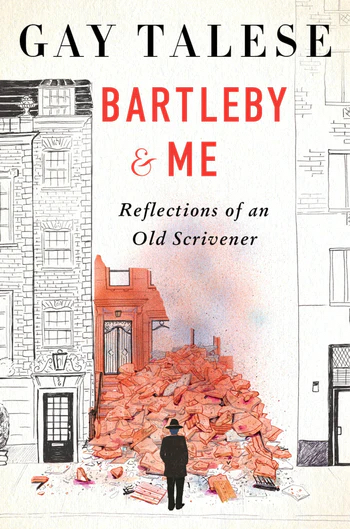“When I joined the Times in the mid-1950’s, I wanted to specialize in writing about nobodies,’’ Gay Talese states in his delicious new collection, Bartleby & Me: Reflections of an Old Scrivener (Mariner Books; 320 pages). The ghost of Melville’s famous refusenik haunts these pages, as Talese—the chronicler of everyone from deaf printers in the Paper of Record’s composing room to Southern California nudist colonies—takes a farewell lap.
At the ripe old age of ninety-one, he hasn’t lost a step.
You can read herein about his first New York Times piece—unbylined, but published on the editorial page, no less—about James Torpey, the electrician responsible for the illuminated sign spelling out the newspaper’s changing headlines on the 42nd Street Times Tower. Or a Times magazine piece on Nita Naldi, a fading actress who once co-starred with Rudolph Valentino, but was living as a recluse in an unnamed Broadway hotel. The peg was a new musical, The Vamp, based on Naldi’s career. Talese called eighty hotels until, he recalls, “to my amazement” the receptionist at the Wentworth Hotel on West 46th Street said, “Yeah, she’s here — who wants her?’’
He quickly hung up, recalling a veteran reporter’s warning: “Young man, never interview anyone over the phone if you can help it.’’ When he showed up at the lobby to ask for an audience, Naldi, admiring the tyro’s spunk, granted him an audience—only to tell him, off the record, that she would have been a better choice for the role than Carol Channing—“after all, I lived the part.’’
Most journalistic collections—the yellowing clips that were once bannered across the front page—are inevitably dated and, most of the time, not particularly well written. But in the past, the jump from city desk to novelistic storytelling was not so daunting, as Hemingway and too many others to count could attest. These days—maybe it’s the fault of the always blameworthy internet—the gap between news gathering (or blogging) and literary fiction seems insurmountable, as if we’re talking about entirely different species, with different customs and vocabularies.
It’s all the more remarkable, then, that Talese’s work still commands, and rewards, close attention. A look back at the circumstances surrounding his famous Esquire piece, “Frank Sinatra Has a Cold,’’ is far from an empty exercise in nostalgia. Although seen as a hit job at the time for its depictions of the Chairman of the Board picking a fight with sci-fi writer Harlan Ellison at a private Beverly Hills club and bullying unlucky underlings, Talese’s latter assessment is more generous.
“As an Italian-American who grew up in South Jersey listening to him on the radio and reading about him in the press during the 1940s, I was inspired by his life, by the way he lived it, and the way other people responded to it,’’ he reflects, citing the youthful Sinatra’s stances repudiating racism and anti-Semitism (the later bromance with President Reagan goes unmentioned.) Remembering the ethnic slurs of his own New Jersey childhood, Talese memorializes the crooner as someone who, after World War II, “emerged as the first fully assimilated United States citizen of Italian origin — one who also paved the way for people like me to finally feel at home in America.’’ The hatchet, if it ever existed, has been officially buried.
I approached the last piece in this collection, “Dr. Bartha’s Brownstone,’’ with some trepidation. This account of a Bartleby-esque doctor (spoiler alert) who blew up his Upper East Side home, along with himself, rather than turn it over to his ex-wife in a divorce settlement sounded like the kind of story Talese might have pitched unsuccessfully to trend-hungry editors, so decided to include it here instead. Their loss. It’s a finely detailed master class of nonfiction fiction, worthy of the late New Yorker writer Joseph Mitchell’s sojourns at McSorley’s saloon or the graveyards of Staten Island. (Never mind the latter-day revelations about some of Mitchell’s journalistic shortcuts, yet another example of the narcissism of small differences.)
Gay Talese may have grown old, and this famously natty man-about-town may even wear the bottoms of his trousers rolled. But he’s—still—just dandy.
Paul Wilner is a longtime poet, critic, and journalist who lives on the Central Coast. He started his career as a copyboy for The New York Times.

